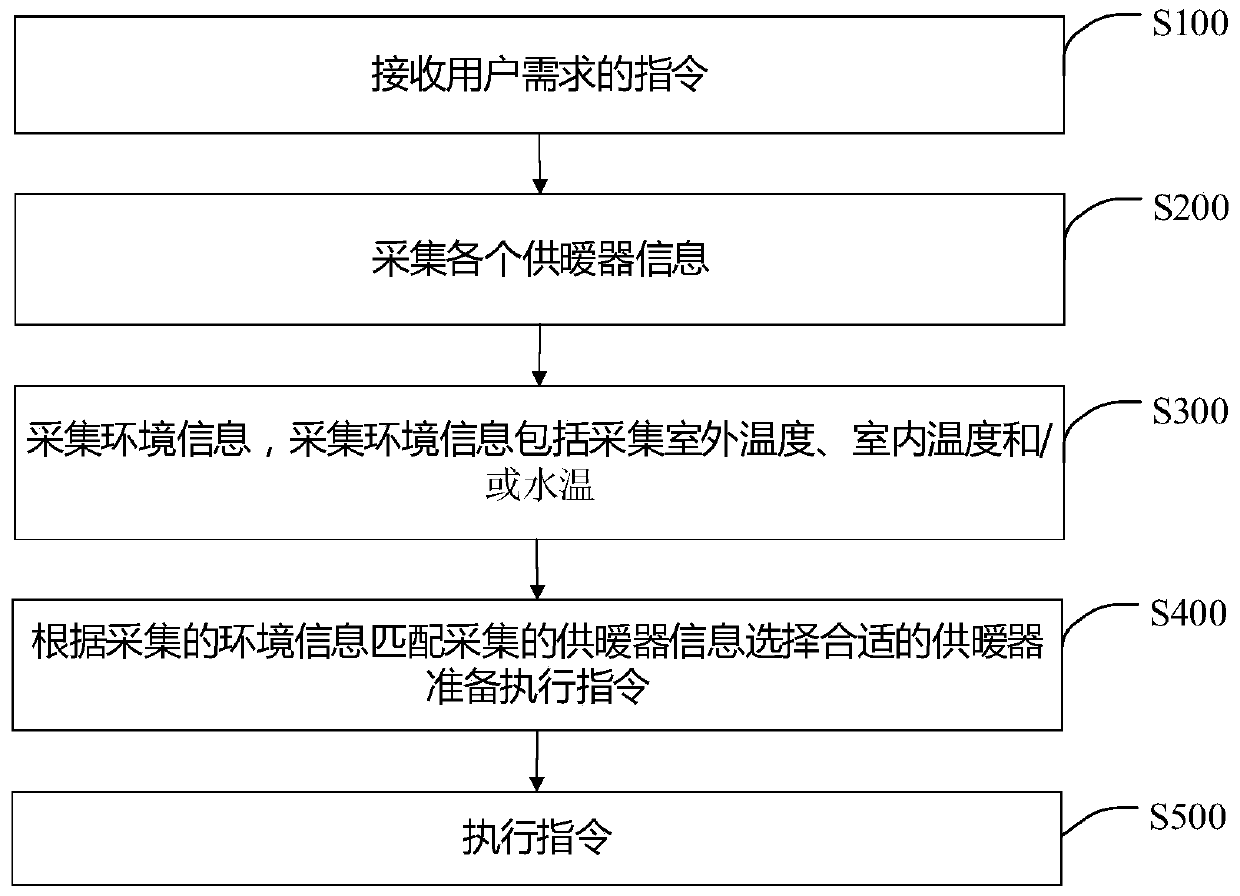Energy-saving heating equipment and control method and system thereof
A technology of heating equipment and a control method, which is applied to the control of energy-saving heating equipment and the field of energy-saving heating equipment, can solve the problems of wasting energy, low degree of automation, poor heating effect, etc., so as to improve the degree of automation, improve the comfort of use, and avoid energy the wasteful effect of
- Summary
- Abstract
- Description
- Claims
- Application Information
AI Technical Summary
Problems solved by technology
Method used
Image
Examples
Embodiment 1
[0050] Since most of the heating equipment in the prior art needs to be manually controlled, the operation is extremely inconvenient. The existing heating equipment generally uses a combination of wall-hung boilers, heat pumps and solar collectors for heating, which cannot be combined with actual conditions. User needs are automatically allocated, resulting in a waste of energy. A solar collector is a device that converts the sun's radiant energy into heat energy. Solar energy is a clean and renewable energy with high economic value. Generally, it is the preferred heating method for the system, but it is easily affected by weather factors and cannot be controlled by humans. Therefore, other auxiliary heating methods are needed to meet user heating needs. need. The heat pump uses the phase change principle of the refrigerant to absorb the heat in the low-temperature air, compress it through the compressor, and convert it into high-temperature heat energy to heat the water. As...
Embodiment 2
[0059] On the basis of Embodiment 1, when selecting a suitable heater for work in this embodiment, the selection is based on the minimum energy consumption standard. Such as figure 2 As shown in , in this embodiment, the following steps are mainly included when matching the collected environmental information with the heater information:
[0060] Step S401, calculating the energy consumption of each heater according to the collected outdoor temperature;
[0061] Step S402, select the heater with the smallest energy consumption and prepare to execute the instruction.
[0062] In actual implementation, since the user's demand command includes the heating request issued by the user or the bathroom request issued by the user, these two demand commands correspond to different usage scenarios, the heating standards are different, and the selection of heaters is also different. Therefore, This embodiment adopts different analysis methods for these two requirements, so as to match ...
Embodiment 3
[0068] Based on the first embodiment, this embodiment controls the heater to work after selecting a suitable heater. Such as Image 6 , including:
[0069] Step S501, connecting the water circuit of the heater ready to execute the instruction;
[0070] Step S502, turn on the circulation pump;
[0071] Step S503, turning on the heater ready to execute the instruction to heat the circulating water in the waterway.
[0072] In specific implementation, such as Figure 7 As shown in , this embodiment provides a waterway connection diagram between various heaters. When a suitable heater is selected, the corresponding devices (including various valves) are opened according to the waterway connection diagram, thereby controlling the corresponding heating The device works and heats the circulating water. Figure 7 The NTC (Thermistor) in represents the temperature probe, which can be used to detect the temperature. Specifically, after the user sends a heating request, when the so...
PUM
 Login to View More
Login to View More Abstract
Description
Claims
Application Information
 Login to View More
Login to View More - R&D
- Intellectual Property
- Life Sciences
- Materials
- Tech Scout
- Unparalleled Data Quality
- Higher Quality Content
- 60% Fewer Hallucinations
Browse by: Latest US Patents, China's latest patents, Technical Efficacy Thesaurus, Application Domain, Technology Topic, Popular Technical Reports.
© 2025 PatSnap. All rights reserved.Legal|Privacy policy|Modern Slavery Act Transparency Statement|Sitemap|About US| Contact US: help@patsnap.com



